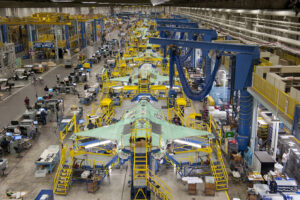
Two F-35C fighters during pre-initial Operational Testing and Evaluation at Eielson Air Force Base, Alaska.
PENTAGON: It’s official — the F-35 Joint Strike Fighter will begin operational test and evaluation next month, marking one of the most significant transitions for the closely watched program. Next summer, presuming no show stoppers appear during OTE, the program will move to full production.
“On October 2, 2018, Undersecretary of Defense Ellen Lord convened an operational test readiness review, which assessed the readiness of the F-35 system and supporting resources required to execute the operational test plan,” her spokesman, Lt. Col. Mike Andrews, says in an email. “Ms. Lord certified readiness to enter operational testing after concurring with the F-35 Program Executive Officer’s recommendation on his plan to start mid-November.”

F-35 production line
I knew the Joint Strike Fighter Operational Test Team (JOTT) had approved the move to OTE on Sept. 23, clearing the path for likely approval by Lord. But her decision also depended on any last-minute objections from Robert Behler, the congressionally-mandated Director of Operational Test and Evaluation. Behler has been much less oppositional in his language about the F-35 than his predecessor, but has continued the careful work of preparing what some call the largest, most expensive and most complex operational test in modern military history.
What does this mean for the program? “Along with its first combat sortie last week, this demonstrates the maturation of the F-35 as the centerpiece of modern US aerospace power,” Dave Deptula, a member of the Breaking D Board of Contributors and head of the Air Force Association’s Mitchell Institute, says in an email.
This has been a huge two weeks for the world’s single biggest military program, as Breaking D readers know:
- First combat mission of a US F-35, a strike in Afghanistan by a Marine F-35B. (Israeli F-35As have already struck targets in Syria).
- The first crash of an F-35, another Marine F-35B, near Beaufort, S.C..
- First takeoff and landing of an F-35B on Britain’s HMS Queen Elizabeth.
- Flight costs per hour plunge $12,000., a critical step towards reducing what the GAO once estimated would be a trillion-dollar cost to buy and operate the F-35 fleet over the decades.
- Lot 11 contract finally inked, with the cost of an F-35A, complete with engine, falling below $90 million for the first time.
Now the entire program takes on the unique operational testing to which America submits its major weapons. One of the things to bear in mind about this is that much OTE data is shared with key international partners, continuing the unique transnational program management that has really distinguished this program from all its predecessors.
Boeing buys GKN factory, ending dispute over F-15, F/A-18 parts
Through the deal, Boeing’s litigation with supplier GKN Aerospace will be dropped, and the aerospace giant will take possession of a St. Louis-area factory it used to own.


























